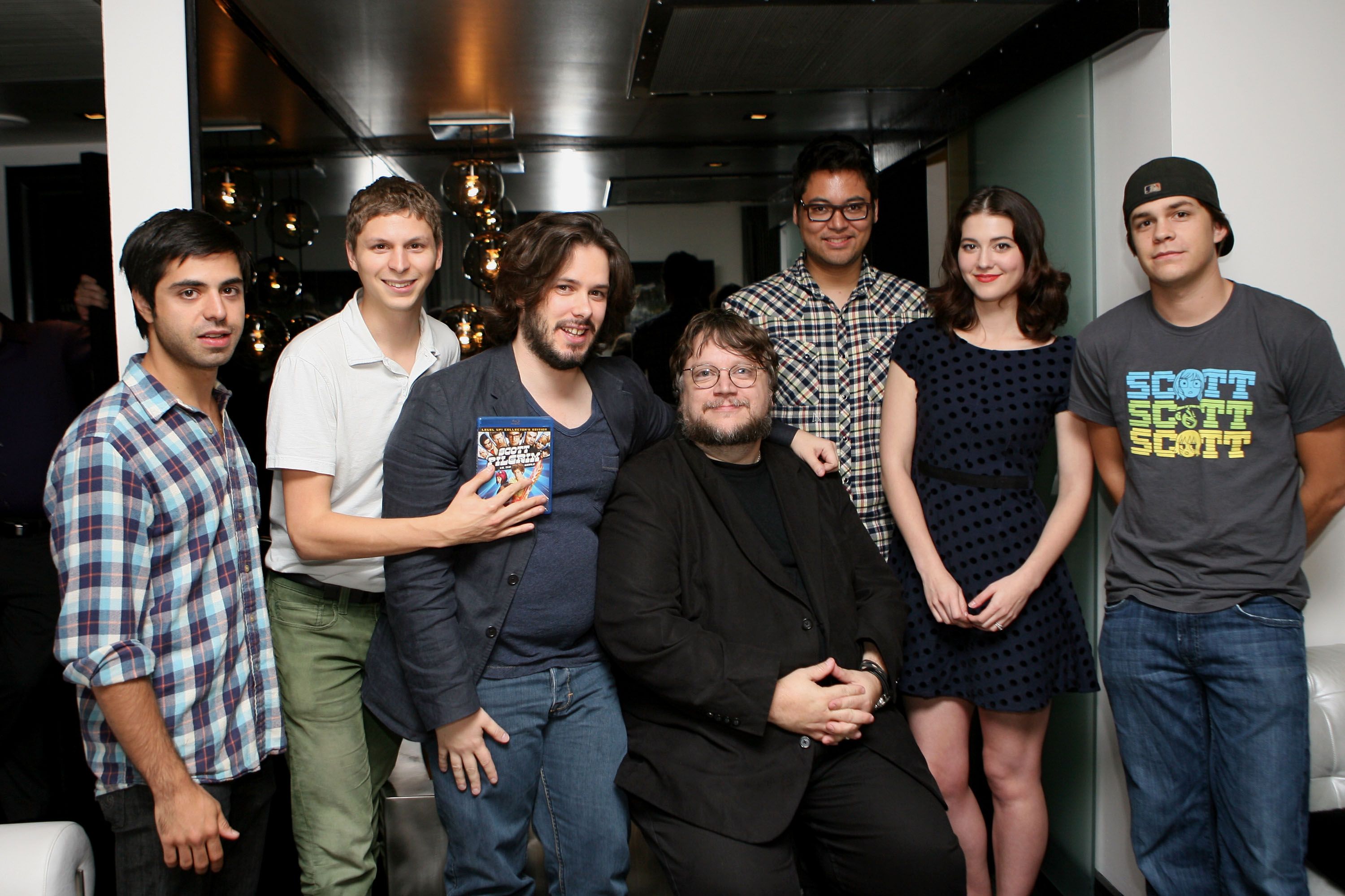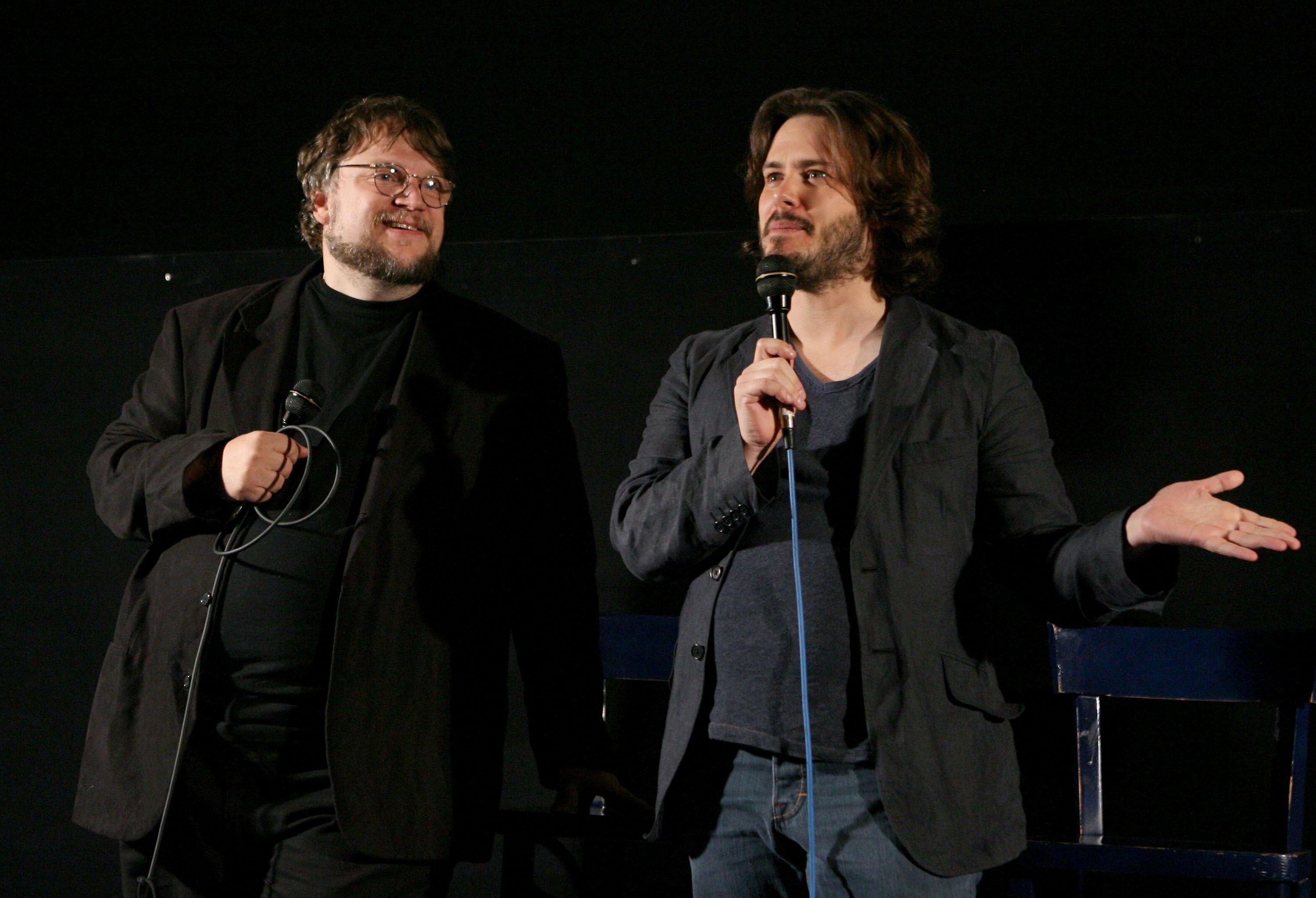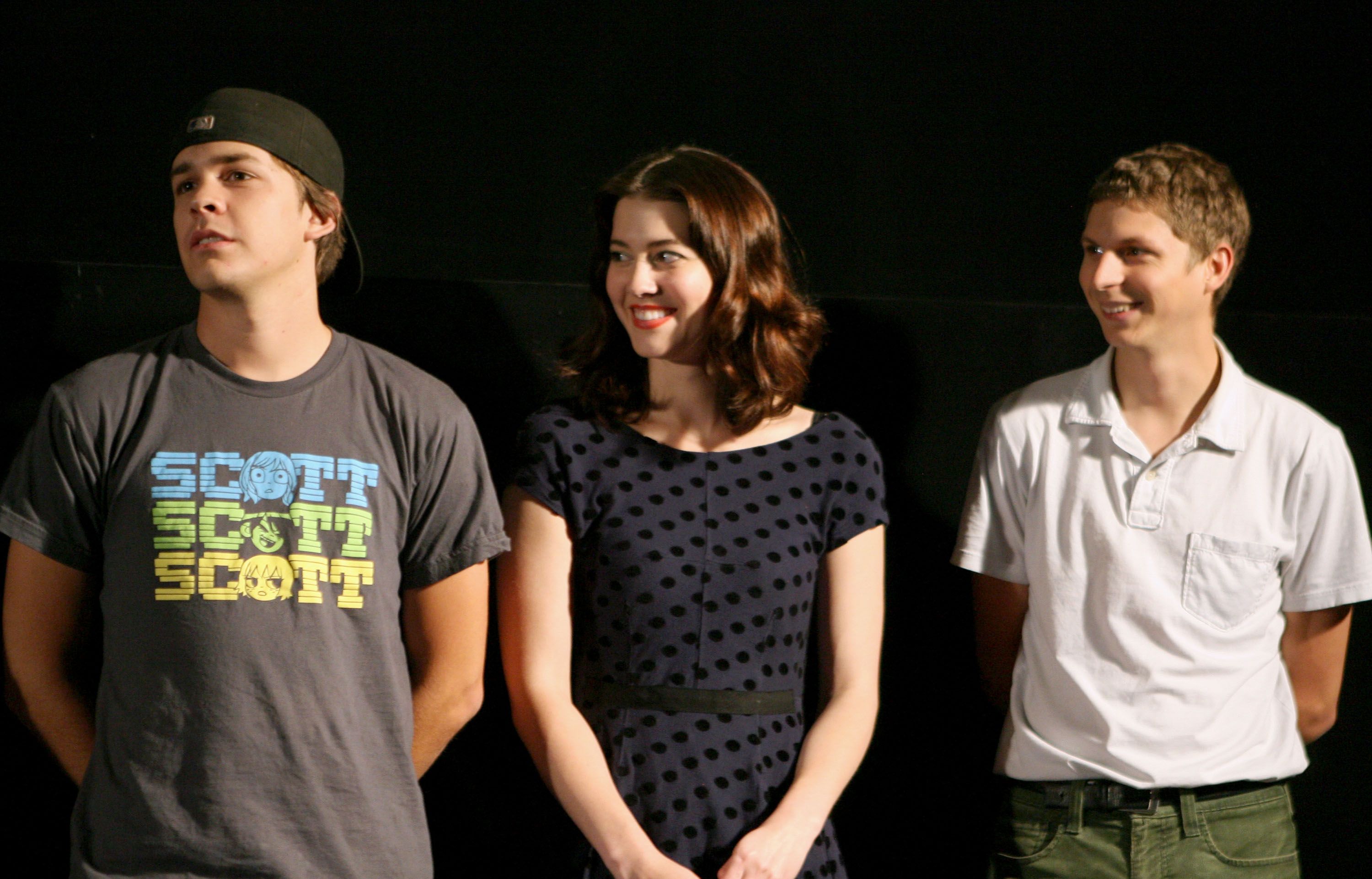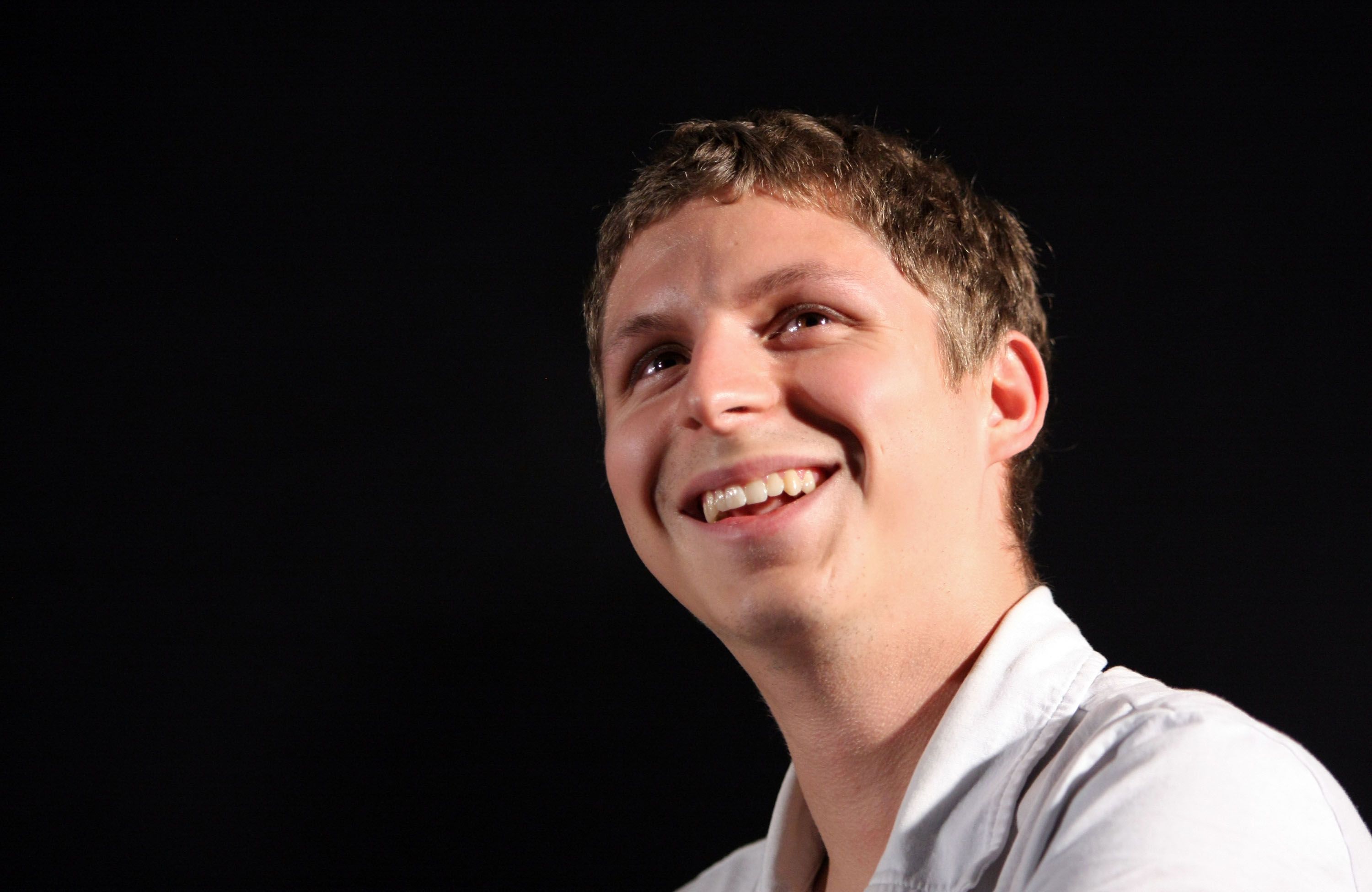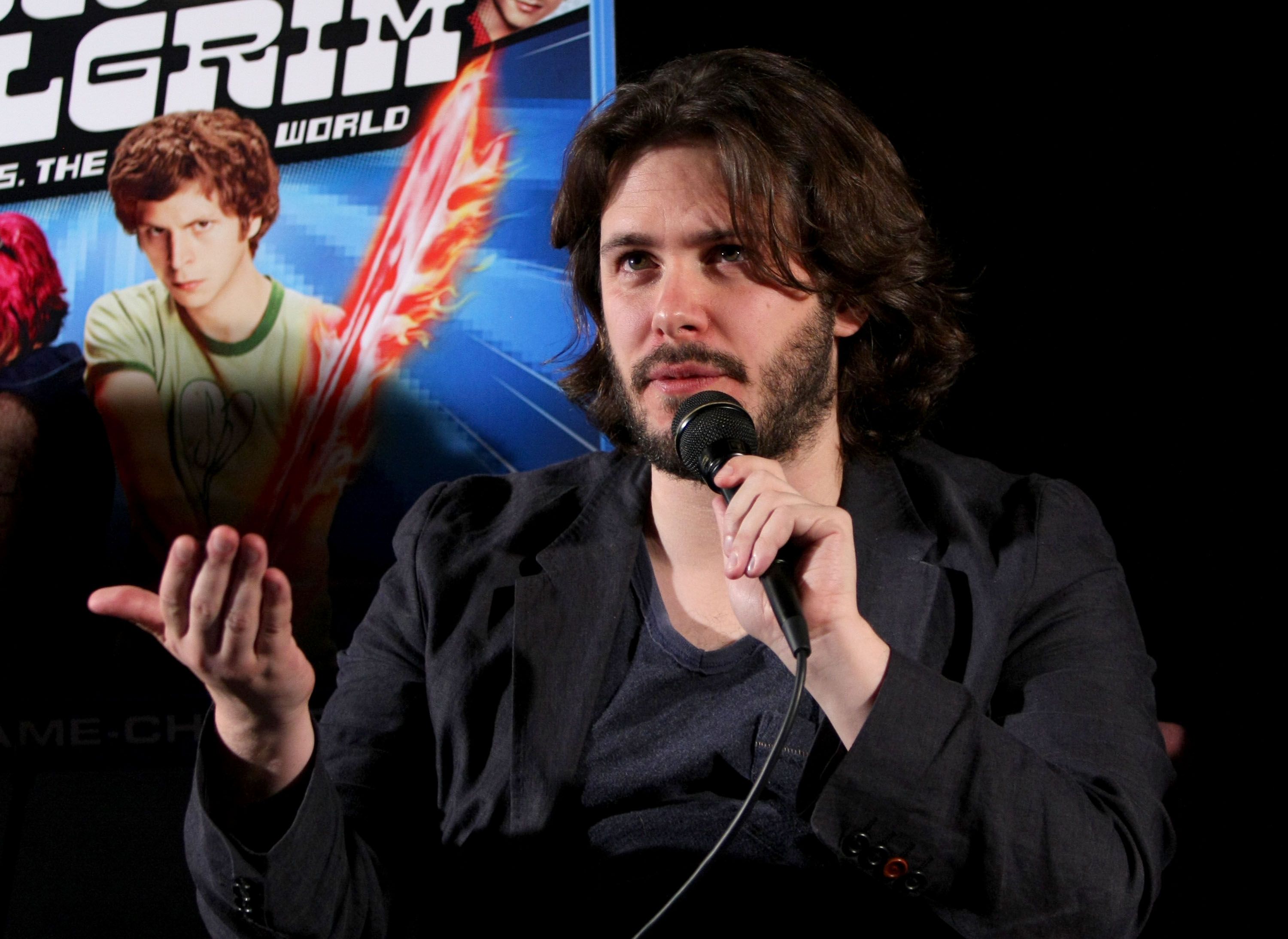Guillermo del Toro hosts a screening and Q&A of the fan-favorite film, featuring special guests Edgar Wright and Michael Cera
One of the best-reviewed films of the summer, Scott Pilgrim Vs. the World, unfortunately was also one of the least successful at the box office. But now, audiences will have a whole new opportunity to discover what so many fans fell in love with last summer when director Edgar Wright's film, which is based on Bryan Lee O'Malley's popular comic book, becomes available on Blu-ray and DVD November 9th. Last week, director Guillermo del Toro (Hellboy, Pan's Labyrinth) joined Scott Pilgrim Vs. the World director Edgar Wright, comic creator Bryan Lee O'Malley and several members of the cast at the Egyptian Theater in Hollywood, CA to screen the film and discuss it with the audience.
The evening began with del Toro expressing his absolute love and appreciation for the film. "People confuse effortlessness with ease and it is one of the hardest things to simulate. Most people associate that with someone winging it or having a good time and it applies to writers and directors too. When you talk about an actor playing himself on a screen that is absolutely not possible. In the same way getting a boner at home is easy, getting it at a facility is pretty hard. Edgar's transitions are absolutely incredibly effortless, fluid, smart, and completely delivered. He is doing it as part of the reason and narrative or the story. There is a deliberate use of saturated colors as the story advances for good reason. Finally, you should try to spot all the extra elements that are in the film."
Before the screening began, del Toro introduced the film's director, Edgar Wright, who introduced his film's cast, which included Johnny Simmons ("Young" Neil), Satya Bhabha (Matthew Patel), Mary Elizabeth Winstead (Ramona Flowers) and Michael Cera (Scott Pilgrim), as well as the creator of the comic book that the film is based on, Bryan Lee O'Malley. Upon Cera's introduction Guillermo del Toro joked that if anyone asked about the Arrested Development movie or The Hobbit that they would be thrown out of the theater. He also introduced stunt choreographer Bradley James Allan who not only worked on Scott Pilgrim but also on Avatar, Kick-Ass and del Toro's Hellboy II: The Golden Army. With that, the film began and the audience quieted down to enjoy the fun, action-packed and music filled cinematic experience.
After the screening del Toro began by telling the audience why this special screening is so important and why they need to tell there friends to see this movie. "I was talking with Edgar and this screening is a very important screening. We are hoping we all can go out to the world and tell every motherfucker to watch the movie," said del Toro. "Why, because anyone who didn't watch it is a Motherfucker! We can tell them since they are Mother fuckers, when they ask why does Hollywood do such shitty movies? Because when they do great ones, you don't fucking show up. This is an inanimately re-watch able movie."
O'Malley continued by discussing his goal with writing the comics. "I always wanted to walk this line between fantasy and reality. In the first part where they burst into battle and song, his friends start acting differently. It becomes his version of everyone. It is all this fantasy construction," explained O'Malley. "It was easier in comics because comics usually are about people fighting. Up to that point, I had done corky Indy movie type stories, having people talking, people driving around having their existence. I wanted to have something with that Indy movie sensibility and with this fighting because that's what comics should be about. You know there are super hero comics, Japanese comics, and there is lots of fighting, so that is where the fighting came from," he concluded.
On the subject of the film's fight sequences, director Edgar Wright talked about getting his lead actor, Michael Cera, to perform those scenes. "There is this element for bringing the books across," explained Wright. "There are some things you can do in Manga that don't come across well in live action. For Michael, when we talked about it, it was half, bringing Michael out of his comfort zone in massive kung-fu battles he had never done before."
"I have no comfort zone, by the way," added Cera. "Half of the idea was seeing him engage in battles like that and grounding the character," continued Wright. "Scott is the hero of the movie inside his own head. Especially when you look at the books like that. Bryan does this moment where a flashback is revealed to be completely different because Scott is an unreliable narrator. But once I had that information, it was a really great way to imagine this movie, playing inside Scott Pilgrim's head. The real version would be like a 16 mm Sundance Indy comedy with no fighting. But Scott has re-interpreted it as this thing with massive kung-fun battles and musical sequences. The reality would be like an echo of the Indy comedy minus the fight sequences," finished Wright.
Recognizing one of the iconic directors who inspired the film, del Toro asked Wright to talk about director Richard Lester's influence on this film. "Richard Lester is one of those directors, I am ashamed to say that I grew up on and then kind of forgot was an influence on me," admitted Wright. "But then when a number of people mentioned it to me about Richard Lester, I kind of realized, I grew up on his stuff. A Hard Day's Night was the fist thing I saw on TV. It occurred to me what a big influence Richard Lester must have been on me. He definitely was an influence. Some of his stuff I watched when I was so young like Help!, Superman II and even Superman III. He is really one of those directors who doesn't get recognized as much as he should, possibly because he just stopped making films in '89."
"I even like big chunks of Superman III and I'm not ashamed to admit it," continued Wright. "I'm a big fan of the Batman TV series. I also like Christopher Nolan's version and Tim Burton's version. What's interesting is the Batman TV series became a dirty word because it was perceived to make super hero films and TV shows less serious. When Superman came back around and started to make things more seriously, that shouldn't take away from the Batman TV series being amazing. This fed into Scott Pilgrim, because of that thrill of the '80s and '90s warp into the present. Comic book movies tried to achieve legitimacy by being serious and the more serious they were, the more they were real films. The Dark Knight was kind of the peak of that in a way. What we tried to do in Scott Pilgrim was to also sort of celebrate the comic form. Flash Gordon landed right in the middle of where it was exactly that bubble gum, pop-up explosion but nobody at the time wanted to know. That is incredibly stylized."
del Toro then asked both Cera and O'Malley to describe there reaction to the film the first time they saw it. "The first time I saw it was at Comic-Con so it was a really good crowd," said Cera. "It played like a rock concert or any kind of music you like. It was very emotional. When I watched the movie I could remember everything that happened while we were shooting and it is still really moving every time I watch. In fact every time I watch it I say to the person next to me, hey if you hear me crying during the movie just wake me up please," the actor laughed.
del Toro then asked the director to discuss the final image of the film? "We originally had a different ending, which we test screened and which in the script existed way before volume six (of the comic). Bryan was still writing volume six when we were shooting," explained Wright. "We'd already tested the film and the ending hadn't gone down well and people were down the middle. When I saw what the final image of the book was going to be I knew that we had to kind of change it. That was great in a way because I think that the final ending that myself and Michael Bacall wrote with Bryan was great. What I like about the final image is that it's open to interpretation. You can interpret it in different ways. I think it works in a similar way as the book as it's open to interpretation as to what it means. Are they going to start again? Are they going to a different place? Are they going to her apartment?"
Next, del Toro explained the three things he hates about working within the studio system and asked Wright how he managed to avoid those conflicts on this film? "There are three bullshit things that a studio will always ask. One of them doesn't apply to your movie, but the first one is, what are the rules? Which is a horrible fucking question," said del Toro. "I want to suffocate them with a sock when they ask, clarify the rules. Fuck you! Second one, which doesn't apply to you, is what's the bad guy's plan? Which makes me want to use the other sock to suffocate them. The final one is when they say, our hero needs to be proactive and not reactive and what's the character arc? Which is a kind of composite, bullshit question. In mapping these things from the three-question point of view, this is a truly hard thing to pull off, isn't it?"
Wright went onto explain that actually it was what del Toro didn't think would have been a problem, the villains plan, that caused the most concern. "One of the things that we re-shot was Jason Schwartzman, just the line about how long it took to get all of the numbers of all of the evil exes. That was shot in May of this year. There's a line in volume six of the comic with Gideon going on Craigslist and I wanted to refer to how he got all of that information together. So we just shot one line kind of as an extra gag, but there's a question about how they got things together as a throw away gag that still kind of fills something in," said Wright. "For the third question, I think you already put it perfectly in terms of Scott as the last to know. The idea, which we took from the books and changed the placing of it, was to have Knives be the person that wakes him up. He cheats on her and you can't do that. The way that it plays out in the film is that he gets killed for that transgression. Gideon kills him for what he did to Knives more than anything else. So his wakeup call comes very late in the day. My interpretation of the ending in the film, at least, is very different from the books because the books have a much longer time line and much more of their relationship is a saga. In a way I feel Scott is actually building up to a second first date. In the timeline of the film, they have to clear out all of the baggage before they can go on a proper date."
Next, Wright was asked to discuss the idea that the film is essentially a musical. "It kind of happened in the first book, the Matthew Patel fight sort of breaks into a Bollywood song and dance number, which is what we did. That probably gave me the idea to pitch it that way. One of the big questions was do we do that big Bollywood number in the film? Absolutely! That's my moment of going for broke, when Matthew Patel starts singing," said Wright. "I felt there was a real link between the fighting and the music. I've always felt that Jackie Chan is the action Gene Kelly and that there is a link between the Eastern action films and musicals."
"Also, I think that a lot of recent action films have gone more into a realistic, gritty feeling," the director continued to explain. "Because it's this feeling of unreality and it's fantastical, it was right to make it feel a bit more like those '80s films where the fights seem like big production numbers. It's got the beats of a musical number. In fact, I think the actors who had to do fights, that most of them had some sort of musical background. Michael Cera and Jason Schwartzman both had musical training or knew how to play musical instruments and even knowing a beat helped. Mary Elizabeth Winstead had done ballets. Mae Whitman had done rhythmic gymnastics, which is where the whole razor belt/ribbon thing came from. So that really kind of helped the actors in a way, the people who had some sort of dance background or musical background found the fights a little bit easier. They found the fights had the beat of a dance routine to them and sometimes we'd play music on the set with some of the sequences."
Finally, an audience member asked Wright if there had ever been any consideration to making Scott Pilgrim Vs. the World into a franchise? "I don't think that ever feasibly came up and given the outcome I'm glad we did make one movie. I'm old enough to remember Ralph Bakshi's The Lord of the Rings and I was pissed there was no part two. As a kid that always used to piss me off that there was no part two. Or at the end of Flash Gordon it says: The End? Yes, it was the end. There was no Flash Gordon 2! So with all of that in mind, I'm glad we did just one film. It never really came up," Wright admitted. "At the time we first pitched it, the book wasn't as much of a best seller as it is now so I don't think we would have been able to go into the studio and sell that. To be honest, even Narnia, which is a billion dollar seller is struggling to get to the third film. I mean, they made one but I think you have to be in that kind of stratosphere of billion dollar sellers, like The Lord of the Rings, Harry Potter or Narnia, to go into a studio and say, it's a six part series! It was never a question." "Though at the end of the DVD you'll see the words: TO BE DISCONTINUED," added Cera.

